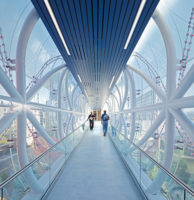A coalition of more than 250 architecture, engineering and construction firms is urging the Biden administration to take “swift executive action” to require higher sustainability standards for U.S. buildings and infrastructure as part of its Build Back Better plan.
On March 12, the AEC Sustainable Leaders Group sent a 10-page Build Back Better letter to the White House with six major recommendations, each containing specific proposals that could be acted on by the executive branch.
“We realized the urgency to design a road map for the Biden administration,” says Chris Hellstern, Living Building Challenge services director for the Miller Hull Partnership and a member of Sustainable Design Leaders—a network within the coalition.
“Our industry’s work must move beyond simply net-zero energy to net-zero carbon,” states the letter. “While combating climate change, we are also dedicated to transforming our communities for the better by addressing critical public health, water, material toxicity and social equity challenges.”
The coalition is requesting action in six areas: enhancing federal building standards, stimulating building reuse and upgrades, promoting healthy housing and resilient communities, electrifying to achieve a carbon-free grid, promoting material health and product transparency, and promoting healthy schools for all.
The letter was addressed to Gina McCarthy, the national climate advisor, and to David J. Hayes, special assistant for climate policy to President Joe Biden. Neither could be reached for comment.
However, “sources within the federal government have told us that they are aware of progress in about nine items within areas we addressed but have no results or public announcements yet,” says Clark Brockman, a principal at SERA Architects and co-chair of the working group that developed the letter with Hellstern and Nadav Malin, president of sustainability consultant BuildingGreen.
The coalition members distinguish themselves from most other groups because they represent architecture, engineering and construction businesses, not individuals, professional societies, academics or researchers.
“As businesses, they can take positions and make the case for business,” says Mike Davis, president of design firm Bergmeyer, and chair of the American Institute of Architects’ government advocacy committee. AIA “is excited about the proposals,” especially those that relate to building codes, net-zero carbon—as opposed to net-zero energy—and electrification, says Davis, who reviewed the letter before it was sent.
Sustainable Design Leaders, which inspired the letter, was formed more than a decade ago by BuildingGreen. Members, representing firms of 50 or more employees, pay an annual fee of $325.
The group is primarily a forum for competitors to have “frank and open” discussion in a “safe space,” says Brockman.
Typically, Sustainable Design Leaders keeps a low profile. But “over the years, we’ve learned there are times when our voice can mean something,” says Brockman.
Sustainable Design Leaders also inspired the formation of parallel networks of sustainable construction leaders, mechanical-electrical-engineering professionals and sustainability consultants, which make up the signatories of the March 12 letter. On its website, BuildingGreen supports and facilitates the groups, which it calls its Peer Networks Hub.
The letter puts federal buildings at the top of the list. Among the proposals: “Direct all agencies to develop and implement design excellence programs that emphasize place-based, outcome-based, climate-responsive design and that require sustainability/environmental peer review focused on whole-building design integration.
“Require all agencies and all projects to follow the ‘Guiding Principles for Sustainable Federal Buildings.’ Direct the General Services Administration and the Dept. of Defense to study, coordinate and implement, across all domestic agencies, the use of IGCC/ASHRAE 189.1 and/or the Zero Code Renewable Energy Appendix to the 2021 International Energy Conservation Code as the minimum energy and sustainability code for all projects.
“Direct GSA to study and implement policies and procedures to reduce the embodied carbon in building materials for federal building projects,” the letter said.
Brockman is optimistic about the future. “We are very buoyed by the administration’s actions over the first hundred days. It is clearly headed in the right direction.”






Post a comment to this article
Report Abusive Comment